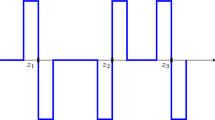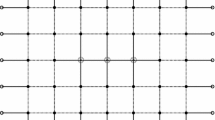Abstract
In place of flows on a discrete network we study flows described by a vector field σ(x,y) in a plane domain ω. The analogue of the capacity constraint is |σ|≤c(x,y), and the strength of sources and sinks is σ·n=λf on the boundary and—div σ=λF in the interior. We show that the largest λ (the maximal flow) is determined by the minimal cut. As in the discrete case the dual problem has a 0–1 solution, given by the characteristic function of the minimal cut; for the continuous problem the argument depends on the coarea formula for functions of bounded variation.
Similar content being viewed by others
References
P. Concus and R. Finn, “On capillary free surfaces in the absence of gravity”,Acta Mathematica 132 (1974) 177–198.
E. DeGiorgi, “Su una teoria generale della misura (r−1)-dimensionale in una spazio adr dimensioni”,Annali di Matematica 36 (1954) 191–213.
H. Federer,Geometric measure theory (Springer-Verlag, New York, 1969).
W. Fleming, “Functions with generalized gradients and generalized surfaces”,Annali di Matermatica 44 (1954), 93–103.
W. Fleming and R. Rishel, “An integral formula for total gradient variation”,Archiv der Mathematik 11 (1960), 218–222.
L.R. Ford and D.R. Fulkerson,Flows in networks (Princeton University Press, Princeton, NJ, 1962).
E. Giusti, “On the equation of surfaces of prescribed mean curvature”,Inventiones Mathematicae 46 (1978) 111–137.
T.C. Hu,Integer programming and network flows (Addison-Wesley, Reading, MA, 1969).
R. Kohn and G. Strang, “Optimal design and convex analysis”, unpublished manuscript.
R. Kohn and R. Teman, “Dual spaces of stresses and strains for Hencky plasticity”, unpublished manuscript.
H. Matthies, G. Strang and E. Christiansen, “The saddle point of a differential program”, in: R. Glowinski, E. Rodin and O.C. Zienkiewicz, eds.,Energy methods in finite element analysis (John Wiley, New York, 1979) pp. 309–318.
E.J. McShane, “Extension of the range of functions”,Bulletin of the American Mathematical Society 40 (1934) 837–842.
G. Strang, “A minimax problem in plasticity theory”, in: M.Z. Nashed, ed.,Functional analysis methods in numerical analysis, Lecture notes in mathematics 701 (Springer-Verlag, Berlin, 1979) pp. 319–333.
G. Strang and R. Kohn, “Optimal design of cylinders in shear”, MAFELAP Conference, Brunel University, England (1981), to appear.
G. Strang and R. Teman, “A problem in capillarity and plasticity”,Mathematical Programming Study 17 (1982) 91–102.
R. Temam and G. Strang, “Duality and relaxation in the variational problems of plasticity”,Journal de Mécanique 19 (1980) 493–527.
Author information
Authors and Affiliations
Rights and permissions
About this article
Cite this article
Strang, G. Maximal flow through a domain. Mathematical Programming 26, 123–143 (1983). https://doi.org/10.1007/BF02592050
Received:
Revised:
Issue Date:
DOI: https://doi.org/10.1007/BF02592050




